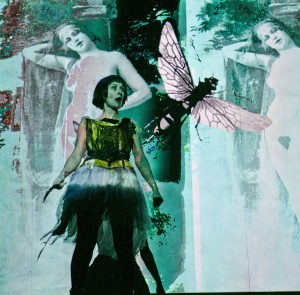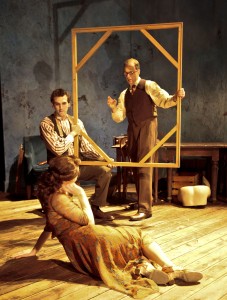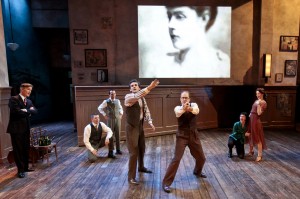The Blue Flower. Music, Lyrics, Script, and Videography by Jim Bauer; Artwork, Story and Videography by Ruth Bauer.
American Repertory Theatre, 12/1/10-1/8/11.
http://www.americanrepertorytheater.org/events/show/blue-flower
Reviewed by Becca Kidwell
The moment the audience enters the doors (actual scenery), they are invited to join Max Beckmann’s collage of memories. An accordion player crosses the stage and roams the audience prior to the start of the show. The stage is in a state of ordered disorder—the perfect working space for creating art. All of the elements (the music, lighting, acting, scenery, and film) swirl around to form a story of love, loss, sorrow and hope.
The performances by the acting ensemble rival Broadway
productions and in some cases even surpass them. Teal Wicks portrays a youthful, yet strong and intelligent, Maria (based on Marie Curie). Of all of the characters, Maria has the most to learn and the most to lose. While not as prevalent in the second act, the audience accompanies her through the disorientation and disillusionment she feels. Wicks’ voice is full of control and emotional power. Lucas Kavner (Franz) complements Wicks’ with his carefree debonair manner. Kavner becomes the charming guy that all the women swoon over and every man wants to be friends with. The only question I have about this performance is: is Kavner acting or just being himself?
Daniel Jenkins (Max) displays an amazing range of skill and presence. Although Max’s memory is the basis for the show, he is also a pawn for the show. Max strives for connection and freedom; while he finds them, he also loses them and then seems more trapped than ever. Daniel Jenkins speaks in three languages: English, German, and “Maxperanto”; to place a dramatic performance on top of that seems challenging, but Mr. Jenkins makes it seem effortless and natural.
It is not difficult to see that Meghan McGeary has spent a long time with the character of Hannah. Her free spirited Dadaist character knows who she is and never falters from that position. Meghan has a countenance similar to Chita Rivera both in vocal ability and grandiose mannerisms that perfectly fit her character. Tom Nelis, the “Fairytale Man”, arranges the scenes and infuses them with energy. At the end of the show, his character becomes reminiscent of Jonathan Pryce in De-Lovely. Connor Christiansen and Paul Shafer round out the ensemble with mastery.
The production does not fit neatly into current expectations of a musical. Perhaps the most analogous theatre form would be Brecht’s “epic theatre”. However, unlike Brecht, the show not only provides the audience with rational reflection and analysis, but also provides a sympathetic position towards the characters. In addition, the show has a plot and a through-line; however, they remain secondary to the visceral experience of the senses. The result is a realization that the war has never ended and the desire for a new way of living never ceases.
The only adjustment that possibly should be made in the future is to set the show in a thrust or arena setting. While the show tries to pull the audience into the action, the formality of a proscenium presentation keeps the audience at arm’s length. Like Sondheim, The Blue Flower most likely will not have widespread appeal, but it will live on as a work of art that both excites and puzzles performers for years to come. TNETG. 12/3/10.



